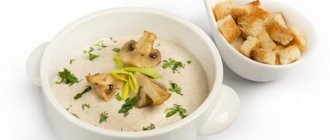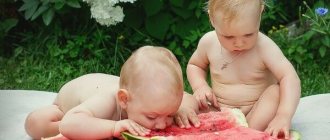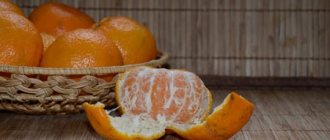At what age can you have pea soup?
We have already found out that the child’s body reacts negatively to boiled peas and dishes made from them. But if you follow certain rules, you can introduce your baby to it at an early age.
- At 2 years old, you can prepare pureed pea soup in a light broth. Give the dish in small portions to monitor your baby's reaction. For younger children, it is better to use a recipe for making vegetable puree for babies at home.
- Traditional pea soup can be enjoyed by children no younger than 4-5 years old. At the same time, it is not recommended to add hot spices and herbs to the dish.
- If your baby has problems with the gastrointestinal tract, it is better to consult a doctor about consuming pea soup.
Cooking features
To prepare children's soup, you need to take a minimum amount of ingredients. The dish should be as simple as possible.
- The soup should be prepared with light vegetable broth.
- If you want to make the dish more nutritious, you can use meat broth made with lean chicken. Chop the chicken meat into small slices, place in a saucepan with cold water, and let it boil. Immediately after boiling, drain the first broth, rinse the meat under cold water and put it back into the pan. Pour boiling water on top and place the saucepan over low heat. After half an hour, the soup will be ready to eat.
- Pre-soak the peas so that they swell well. Leave it in the water for at least 10 hours.
- The ideal set of ingredients for making baby pea soup is onions, potatoes, carrots and beans. Vegetables do not need to be fried. Throw them raw into the broth.
- You should not add spices and herbs if the child is under 6 years old.
Important advice! You should not give your baby nuts, fish or sausages on the same day as pea soup. Disturbances in the gastrointestinal tract occur due to the fact that peas act as a catalyst. By itself, it does not cause flatulence or constipation.
Making soup
Dishes made from legumes are deservedly popular. These delicious diet treats are on many people's menus. Peas are the leader among other relatives, and the most common dish made from them is soup. He is loved and popular in many families. When a child appears in a family, a logical question arises: when can children be given pea soup, which is cooked at home quite often.
Pea soup for a child
Peas contain vitamins, essential microelements and a lot of protein. It activates the nervous system and brain. As a complete meal, pea soup can be given to a child after 1-2 years. If before this time the baby eats a spoonful of such soup, for example as educational complementary food, there will be no harm.
Pea soup, like any new dish, should be introduced gradually. Start with one or two spoons, watching the baby's reaction. Although legumes are a dietary food and contain a large amount of protein, they cause excessive gas formation.
So, having found out whether your child can have pea soup, you need to prepare it correctly. After all, the classic recipe for smoked ribs is not suitable for use by a small child. There are several basic principles for preparing soups (not just pea, but any) for children after one year:
- Cook the soup using vegetable broth.
- You can make soup with meat broth. To do this, you need to use low-fat pulp, finely chopped. Place the pieces of meat in cold water. After boiling, remove the meat and drain the water. Rinse the meat with cold water and pour boiling water over it. After half an hour of slow simmering, the broth is ready.
- For quick boiling, it is better to soak peas in cold water in the evening.
- We put the ingredients for the soup in descending order of their cooking time: peas, carrots, potatoes, onions.
- First, it is better to prepare puree soup - this will make it easier for the baby to eat and for the stomach to cope with its processing.
When making pea soup for children under three years of age, it is better to use fresh or frozen green peas rather than dry split peas. This way the dish will be more dietary, healthy and light. You can start giving this soup to babies after six months.
To make things easier for mom, you don’t have to cook pea soup for your baby separately. Just dilute the soup, which was cooked for the whole family, with water or vegetable broth twice.
yellow pea puree
With the arrival of warm days, I want to diversify my diet with fresh foods, vegetables and fruits. And, of course, with the appearance of peas, it’s hard to deny yourself the pleasure of eating them fresh or preparing some kind of dish. Vitamins in green peas are represented by group B, A, C and H, and it also contains a considerable amount of carotene.
But the number of mineral substances is off the charts; there are about 26 of them. In this case, most of all there is iron, phosphorus, calcium, magnesium, and selenium. As you know, all legumes are primarily valuable for their proteins and carbohydrates; in addition, they contain fats and sugar. This composition makes this product high in calories, since there are 300 kcal per 100g, thanks to which the feeling of fullness comes quickly and remains for a long time.
The vitamin complex of green peas has long been noted by doctors and nutritionists. Therefore, its beneficial properties are actively used for healing. For example, due to the large range of vitamins and minerals, it is recommended to include fresh peas in your healthy diet, since it is during this period that vitamin deficiency occurs.
Green peas are useful not only because of their vitamins, but also because, unlike many green vegetables, they do not accumulate nitrates, which are so dangerous to human health. Doctors have long noted that dishes with the addition of fresh peas help cleanse the body of radionuclides.
But the beneficial effects on the human body do not end there, because with regular use, the risk of heart attack, hypertension, and cancer is reduced. And for women, this is a particularly valuable product, because it helps maintain youth, as it slows down the aging process in the skin.
For children, this product is valuable primarily because it is rich in vitamin C and selenium, which prevent the development of anemia. Plus, the rest of the vitamin and mineral composition will be very useful for the normal growth and development of the child. But at what age can you give green peas to a child? After all, each product must be introduced at a certain time into the baby’s feeding, so as not to harm him.
We suggest you read: List of things to do at the birth of a child
From eight months you can already give this product in the form of puree. It is from this age that the baby’s pancreas begins to produce the necessary enzymes that can digest peas. Starting to give green peas to your baby at 8 months is very important for the normal functioning of the gastrointestinal tract later on.
For your baby, you need to prepare pea puree; this consistency will be easy to digest, digest well and not cause any discomfort. Some children are predisposed to food allergies, but in the case of fresh peas, mothers should not worry, since they are absolutely hypoallergenic and therefore completely safe for the baby and will not cause allergic reactions.
Of course, there are many different purees sold in stores, but there is nothing better than homemade homemade food. Therefore, try to prepare the puree yourself. To prepare green pea puree for your child, just boil it a little and puree it with a blender. For the first time, you can give very little, just a teaspoon, this is about 5g. After every three days, this amount can be increased by 5g, while the maximum serving should be no more than 50g.
In this case, you can eat fresh peas and give them raw, but such an experiment is better to carry out later, when the digestive system has already become accustomed to the new food. At the same time, be sure to monitor the reaction and well-being of the baby. Whenever introducing new foods into your diet, this must be done in stages. To do this more safely, you can combine it with already familiar vegetables.
Peas belong to the legume family; this plant is an irreplaceable source of proteins, vitamins and fiber. Pea dishes should be in everyone's diet to replenish nutrients, but can children eat green peas? And if it is so useful, then at what age can you start feeding your child pea puree and soups?
Green beans contain a large amount of useful minerals and trace elements, such as potassium, phosphorus, calcium, magnesium, chlorine, cobalt, etc. Potassium, calcium and magnesium are simply necessary for the normal growth of the baby and the proper development of bones and the functioning of the cardiovascular system.
Peas also contain several groups of vitamins - A, PP, H, E, K and B. In addition, the beans of this plant contain useful beta-carotene.
Peas are extremely useful in their pure form, but children from one to three years old should never be given whole peas, otherwise the child may choke. It is better to start complementary feeding with puree; this product is no less healthy than whole beans, tasty and nutritious.
Kids are very energetic, and this porridge will give them new strength, saturating the child’s body with the energy necessary for growth. Pea porridge contains a lot of protein of plant origin, which promotes the growth of the child, helping to gain healthy body weight.
In addition, green pea porridge is easily digestible, which is very important for children under one year of age. Peas do not cause constipation, rather the opposite, so it is better to give pea dishes in limited quantities to babies prone to diarrhea.
Peas contain antioxidants, which means that this porridge can be given to children with various skin diseases, as well as for their prevention.
There is often a popular myth among parents that legumes will make the baby swell, but in reality this is not the case. To avoid increased gas formation, it is enough to know a few nuances when feeding a baby up to a year with green pea puree.
How to lose weight after childbirth?
Many women after childbirth face the problem of excess weight. For some, it appears during pregnancy, for others, after childbirth.
- And now you can no longer afford to wear open swimsuits and short shorts...
- You begin to forget those moments when men complimented your flawless figure...
- Every time you approach the mirror, it seems to you that the old days will never return...
But there is an effective remedy for excess weight! Follow the link and find out how Anna lost 24 kg in 2 months.
Buy only the youngest beans, fresh or frozen; the ideal option is peas from your own garden beds, if you have them. Mature varieties of peas should not be given to children under one year of age, only after 2 years.
Do not give the beans whole; puree them, because the child’s body cannot yet fully absorb such peas. Canned peas, as well as dried beans, can be given to a child only after 3 years.
Complementary foods in the form of pea puree should appear in the baby’s diet no earlier than 8 months. At a younger age, the pancreas does not yet produce the enzymes necessary to digest peas.
- To boil green legumes for your child, they should be washed and soaked briefly (5-10 minutes). To cook, add a large volume of water to the product, bring to a boil and do not cover with a lid. You can add salt to the dish at the end of cooking.
- If you are preparing mature legumes for your child, after carefully sorting and washing them, they should be soaked in cool water for 3 or 4 hours. Next, they are also boiled at high boiling in a large volume of water, without covering with a lid, and salt is added to taste at the end of boiling. Then they are made into puree.
- The menu of a child over 2 years old may include not only pea porridge and bean puree, but also legume dishes such as meatballs, casseroles, salads, stews and others.
- It is better to give such products along with vegetable dishes, since combining beans, peas and other legumes with animal protein impairs their digestion.
Green peas for children
What else should not be included in the recipe?
In addition to spices and frying, there are a number of products that cannot be added to children's dishes. These include:
- bouillon cubes. They contain a large number of chemical additives, so they will not bring any benefit to children. It is better for adults to avoid them too;
- smoked products. They are included in the traditional recipe, but smoked meats should not be on the children's menu;
- fatty meats. A child’s body will not be able to digest fatty meat, so only lean chicken fillet can be used for cooking.
Pea soup for a child should be prepared according to all the rules. Only in this case will they benefit him.
Doctor Komarovsky talks about healthy and unhealthy food in the video.
By
Benefits of the legume family
Many mothers are happy to eat legumes themselves, but are afraid to introduce them into their son or daughter’s diet, believing that these products will harm the child’s delicate digestive tract. They doubt whether a one-year-old child can be given peas, lentils and beans, and they often do not know what dishes are prepared from legumes for the children's menu. Let's dispel fears and clarify when it is permissible to introduce soy, peas and other products from this group into children's diets.
- They contain a large amount of proteins and fiber, thanks to which they combine the advantages of meat and vegetable dishes. Soybean is considered the most valuable legume in terms of protein content. It is recommended if it is impossible to consume meat or milk, for example, with lactase deficiency.
- They contain a lot of vitamins. In particular, soybeans contain a lot of beta-carotene, vitamin D, choline, biotin, folic acid, vitamin E and B vitamins. Beans and green peas contain a lot of vitamins C, PP, group B, vitamin K, carotene.
- They are a source of mineral compounds. From beans, the child will receive copper, zinc, iodine, calcium, magnesium, iron and other minerals. Peas are a valuable source of selenium, magnesium, calcium and iron salts, phosphorus, iodine and potassium.
- The consumption of such products helps to remove radionuclides, heavy metals and other harmful substances from the human body.
- They are actively involved in the functioning of the digestive system. Their use increases the production of gastric juice and facilitates bowel movements.
- In addition to B vitamins, lentils contain healthy omega fats, magnesium and iron.
- Lentils are called an environmentally friendly product because they do not accumulate harmful compounds and can be safely consumed by children.
- Beans have antimicrobial, sugar-lowering and diuretic effects.
- Eating green peas helps prevent anemia.
- Peas, soybeans, beans and other legumes are considered hypoallergenic foods.
The introduction of such products into the children's diet too early or their excess causes increased gas formation in the intestines, as well as constipation. Ripe legumes are indeed quite difficult to digest, so they are soaked before cooking and offered to children in small quantities. If you follow these recommendations, all the disadvantages can be avoided.
Green peas are useful for children especially because they contain a lot of vitamin C and selenium, which is a good prevention of anemia. Children need beans because they are rich in vitamin F, zinc and copper, which a small child needs for full growth. And iodine makes beans an excellent antimicrobial agent.
Soy is rich in vegetable protein. It is especially indicated for children suffering from lactase deficiency and milk intolerance. Soy also contains few carbohydrates, so it can be given to children prone to obesity.
Lentils are the most environmentally friendly product because they never accumulate nitrates and toxins, so they can be given to children without fear.
All other legume family products can be introduced to a child only from 18 months. First offer your child soy and lentils. Lentils contain a lot of sugars, which are a breeding ground for intestinal bacteria, and soybeans are rich in plant proteins necessary for growth. For a child aged 1.5 to 3 years, the maximum daily dose of legumes should be about 100 grams.
- Peas are legumes, which means they are an excellent source of vegetable protein. The composition of the protein is complete and contains the optimal amino acid composition necessary for a growing organism.
- Hypoallergenic product.
- Pea dishes contain a lot of vitamins and microelements - folic acid, calcium, phosphorus, iodine.
- Thanks to the composition of microelements described above, pea dishes stimulate brain function.
- Peas have an effect on the hematopoietic system, which prevents anemia.
- Reduces the likelihood of the formation of malignant tumors - this effect is achieved due to the selenium, carotene and fiber contained in peas.
– Fresh peas have a slight laxative effect.
— Pea puree coats the stomach and reduces high acidity.
— Natural prebiotics and fiber normalize the microflora in the intestines.
— Suitable for feeding low birth weight babies.
— A high content of folic acid is necessary for the development of the child’s nervous system.
— Antioxidants and group vitamins help eliminate toxins and improve immunity.
Peas are a plant from the legume family, the seeds of which are eaten both green and ripe. Many different dishes are prepared from them in many countries around the world.
Green peas are consumed raw at the stage of milk maturity. It is juicy and sweet, its pleasant delicate taste is liked by both children and adults.
Parents are interested in how beneficial it is for children, and at what age can green peas be given to children.
The chemical composition of green peas is rich. It contains many substances that are beneficial to the child’s body and ensure the normal function of internal organs.
Its energy value is low: 100 g of fresh vegetable contains about 80 kcal (canned green peas contain only 55 kcal/100 g, and mature dry peas contain about 300 kcal).
The nutrients of green peas are (per 100 g):
- vegetable proteins – 5.2 g;
- carbohydrates – 13.6 g (including fiber 4.5 g);
- fats – 4 g;
- water – about 80 g;
- ash – 0.7 g.
Proteins include:
- Ten essential amino acids:
- valine;
- leucine;
- arginine;
- histidine;
- methionine;
- lysine;
- tryptophan;
- trionine;
- phenylalanine;
- isoleucine.
- Eight nonessential amino acids:
- glutamic acid;
- alanine;
- aspartic acid;
- proline;
- glycine;
- cysteine;
- tyrosine;
- serine
Carbohydrates are represented, in addition to dietary fiber and starch, by simple sugars:
- fructose;
- sucrose;
- maltose;
- glucose.
Fats contain saturated and unsaturated fatty acids.
Green peas contain vitamins:
- fat-soluble (A, K, E, alpha and beta carotene);
- water-soluble (B1, B2, B4, B5, B6, B9, PP, C).
Macroelements of peas are calcium, phosphorus, potassium, sodium, magnesium.
Microelements: manganese, zinc, iron, selenium, copper.
Peas are extremely rich in protein and other substances necessary for the body.
The beneficial properties of green peas are associated with its composition:
- Like other legumes, peas contain a significant amount of protein - its content can be compared to beef. But plant protein is absorbed better and easier than animal protein. Proteins are necessary for the formation of tissues in the child’s body and for gaining body weight.
- In terms of vitamin content, green (young) peas are superior to ripe ones, consumed in the form of cereals.
- Peas contain a lot of flavonoids (natural antioxidants), which neutralize radionuclides and help cleanse the body of under-oxidized metabolic products in tissues and other toxic substances. Antioxidants prevent the formation of malignant cells, so eating green peas is a cancer prevention measure. Antioxidants will also help cope with various skin diseases.
- Calcium and phosphorus contained in peas contribute to the harmonious development of the skeleton and ensure the strength of bones and tooth enamel.
- Potassium and magnesium, as well as vitamin PP, ensure normal functioning of the heart muscle and the correct rhythm of heart contractions.
- Zinc and selenium improve the condition of the retina and lens of the eyes.
- The fiber contained in the vegetable improves the functioning of the gastrointestinal tract and helps cope with chronic constipation. True, abuse of the product will lead to increased formation of gases in the intestines and bloating, and the load on the kidneys will also increase.
- Peas contain pectin (a natural or natural probiotic), which helps normalize intestinal microflora.
- Due to the large amount of nucleic acid contained in green peas, it helps to increase regenerative processes in tissues. Therefore, peas are a product that accelerates the healing of wounds and burns: in folk medicine, a product is used in the form of a mixture of fresh raw chicken eggs and chopped peas. Nucleotides combine well with magnesium, which improves their absorption.
- Ascorbic acid not only helps to increase the body's immune strength, but also strengthens the vascular wall.
- Eating green peas has a general tonic effect, helping to cope with emotional stress and mental fatigue.
We invite you to read: What you need in the first days at home with a newborn baby The first day at home what next
It is important that green peas are a low-allergenic product, that is, the occurrence of an allergy after consuming it is unlikely. It can also be given to children prone to allergies.
Possible harm
For children under 2 years of age, it is better to chop green peas to prevent the child from choking. During the first 2 years, it is recommended to feed green peas after heat treatment (boil or stew them) to facilitate the absorption of plant proteins.
- If a child has manifestations of colitis (inflammation of the intestines), a tendency to diarrhea and bloating (flatulence), the green vegetable should be given with caution, as it can aggravate the process.
- Bloating and colic in a baby can occur with excessive consumption of green peas.
- Green peas are contraindicated for children with kidney disease due to their high content of purines - special substances that turn into uric acid when broken down. Salts of this acid (urates) can form stones.
A child under one year old can be offered green peas as a single component or in combination with other pureed vegetables.
Green peas can be included in children's menus from 8 months after the baby already eats vegetables, cottage cheese, and meat. Until 8 months of age, the pancreas does not yet produce enzymes to digest this vegetable.
If you don’t start introducing green peas into your baby’s diet at this age, then his digestive system will not learn to produce the necessary enzymes, and in the future the child will have digestive problems when eating legumes.
In season, you can use fresh green young peas. At other times, you can purchase jars of ready-made green pea puree in the baby food department. There are also dishes with the addition of green peas.
For the first test, it is recommended to give the baby 0.5-1 tsp. (5 g) pea puree. Its delicate consistency makes it easy to digest. If the product is well tolerated, the dose can be increased every 3 days by 5 g, and so the daily portion of the vegetable gradually increases to 30-50 g.











